人教版高中英语必修2 Unit 4 Wildlife protection 阅读课How Daisy Learned to Help Wildlife课件(共23张)
文档属性
| 名称 | 人教版高中英语必修2 Unit 4 Wildlife protection 阅读课How Daisy Learned to Help Wildlife课件(共23张) |  | |
| 格式 | zip | ||
| 文件大小 | 7.8MB | ||
| 资源类型 | 教案 | ||
| 版本资源 | 人教版(新课程标准) | ||
| 科目 | 英语 | ||
| 更新时间 | 2020-03-26 12:01:38 | ||
图片预览

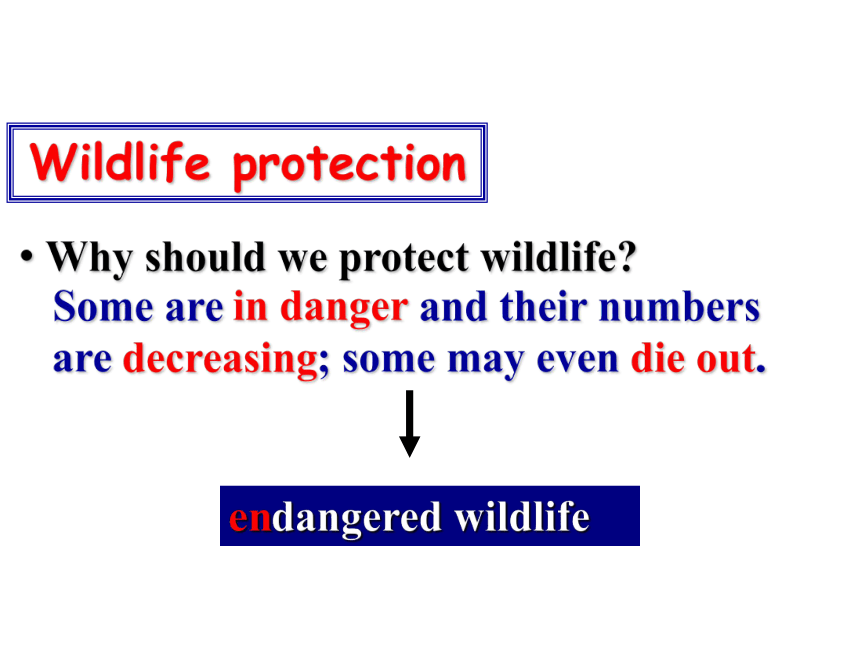
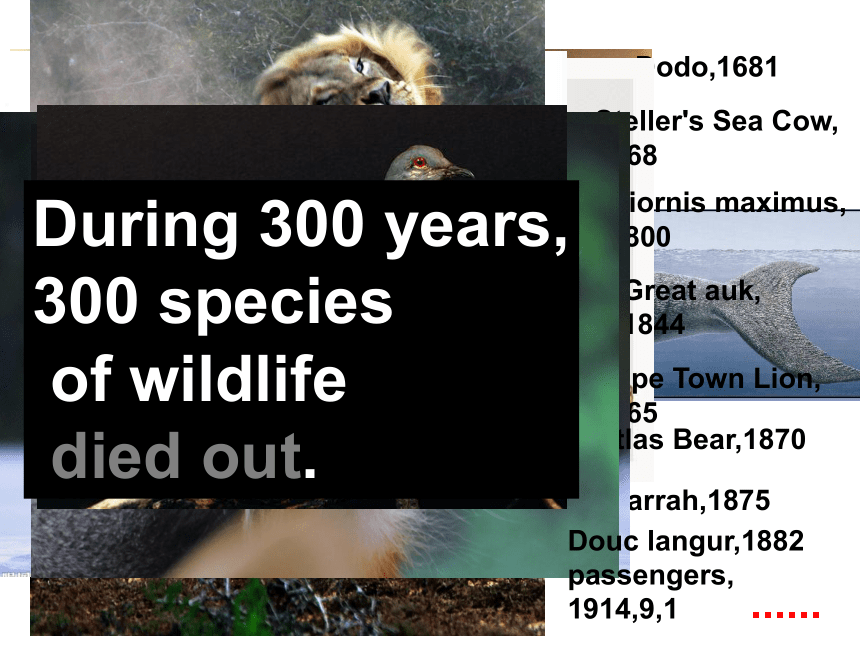
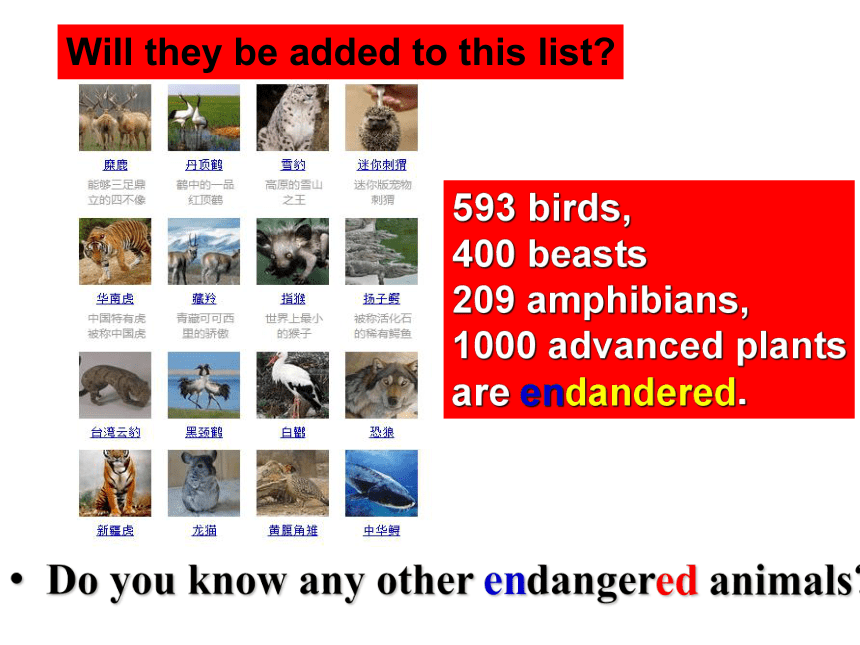
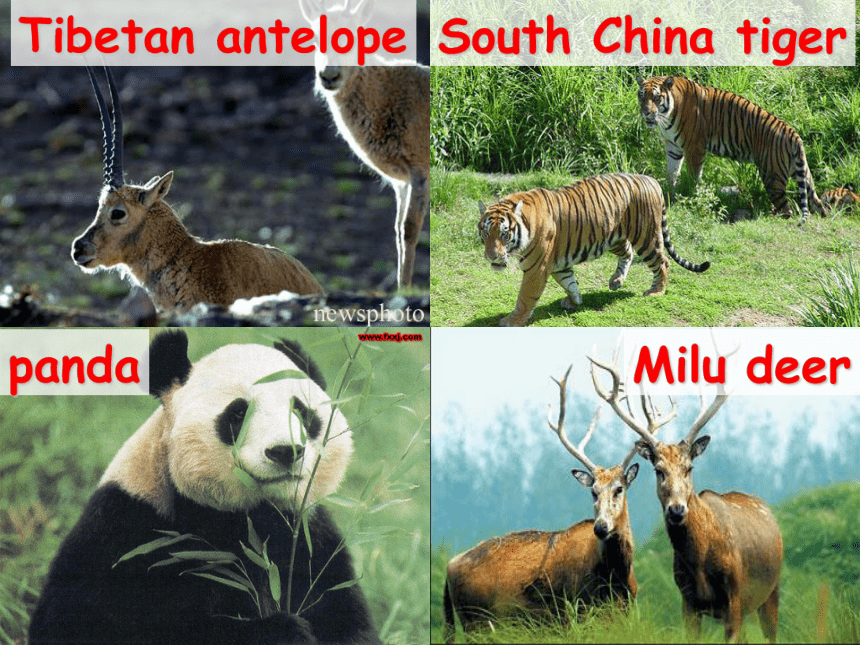
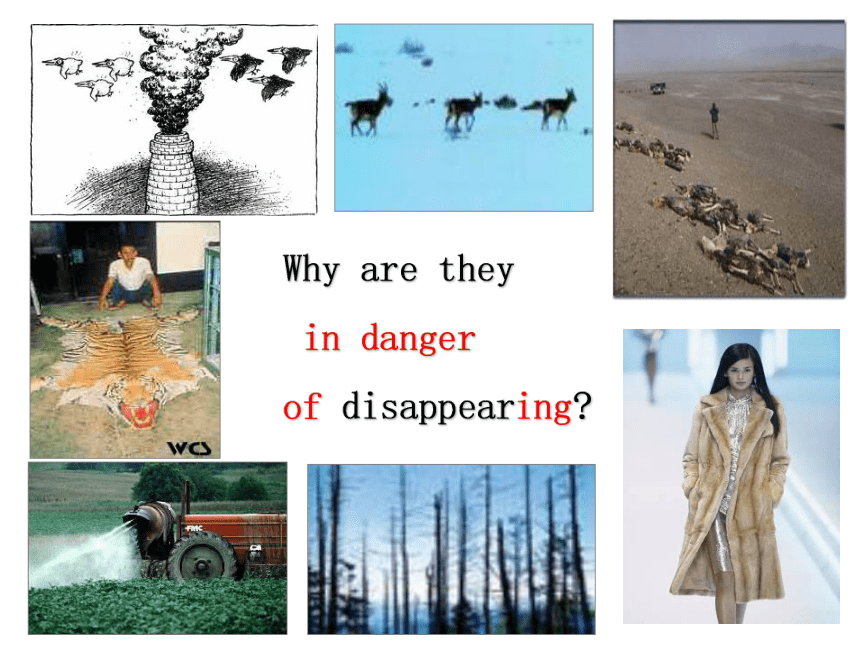

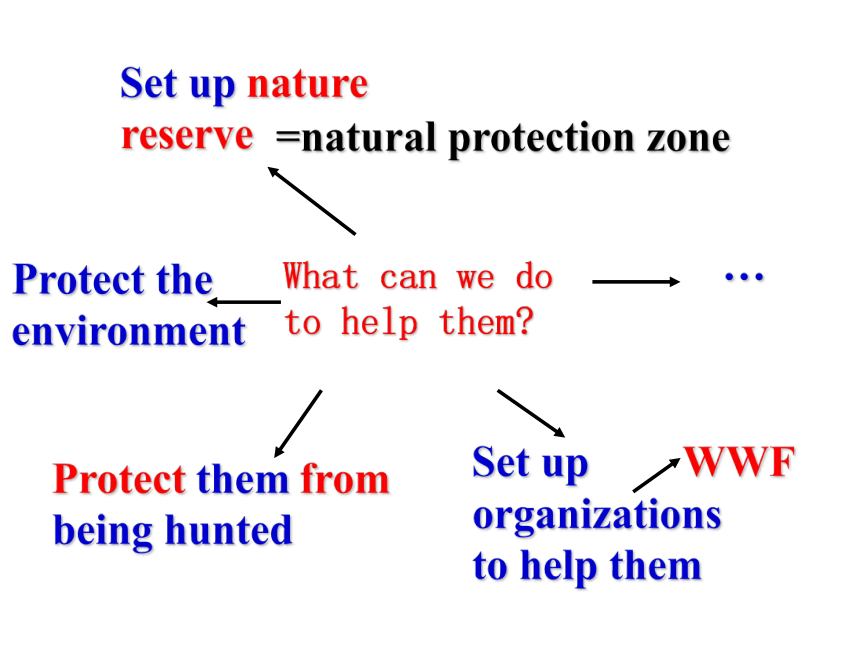

文档简介
(共23张PPT)
Unit 4
Wildlife protection
Wildlife protection
Why should we protect wildlife?
Some are in danger and their numbers are decreasing; some may even die out.
endangered wildlife
Dodo,1681
Diornis maximus,
1800
Steller's Sea Cow,
1768
Great auk,
1844
Cape Town Lion,
1865
Warrah,1875
Atlas Bear,1870
Douc langur,1882
passengers,
1914,9,1
......
During 300 years,
300 species
of wildlife
died out.
Will they be added to this list?
593 birds,
400 beasts
209 amphibians,
1000 advanced plants
are endandered.
Do you know any other endangered animals?
Tibetan antelope
South China tiger
Milu deer
panda
Why are they
in danger
of disappearing?
Why are they
in danger
of disappearing?
loss of habitats
life threatened by enemies
hunted by human beings
lack of food
climate change
…
What can we do to help them?
Set up nature reserve
=natural protection zone
Protect them from being hunted
Set up organizations to help them
Protect the environment
…
WWF
What’s the report about?
There has been some progress in saving endangered wildlife in China.
Reading skill:
Pay attention to the lines/ information above or below a table or chart.
What is the progress?
How was the progress made?
P25
Which animal has been most successfully protected?
Why are the reserves being used to protect bamboo areas rather than the pandas?
Introduce one of them.
The problem the pandas face in China is that they do not have enough food because of the loss of bamboo growing areas. To solve this problem, China has set up a protection zone in Sichuan Province for the pandas. It is called the Wolong Nature Reserve. Because of that, things have changed for the better. The number of pandas has risen from very few to about 1,600 after the increase of bamboo areas for the pandas.
How Daisy Learned to Help Wildlife
How has Daisy learned to help wildlife?
Guess the main idea of the text.
What helped Daisy learn to help wildlife?
What animals did she meet? Where?
How Daisy Learned To Help Wildlife
A flying carpet.
An antelope (in Tibet)
An elephant (in Zimbabwe)
A monkey (in a thick rainforest)
What situations are they in?
antelopes in Tibet
elephants in Zimbabwe
monkeys in a thick rainforest
They’re being hunted for the _____ beneath its stomach. As a result, they are now an ___________ species.
wool
endangered
In the past, they were _______ without mercy. But now they are protected by farmers.
As a result, their numbers are ___________.
hunted
increasing
They produce a drug naturally to _______ themselves from mosquitoes.
protect
How Daisy Learned to Help Wildlife
Reading
True of False?
1. The flying carpet took Daisy to some places nearby to see some endangered species.
2. The tourists in Zimbabwe are allowed to kill animals without mercy if they pay.
3. Millipede insects can be used to produce a drug which affects mosquitoes.
4. Daisy was unable to make her new drug because the monkey disagreed to help her.
distant places
a certain number of…
everything had gone as she landed.
A. Tourists hunted them without mercy.
B. The farms were destroyed so seriously that
they had no habitats.
C. The government encouraged tourists to
hunt them.
D. Farmers hunted too many elephants.
1. Why did elephants use to be an endangered species in Zimbabwe?
Comprehending
A. It considers itself a beautiful animal.
B. Elephants are friendly to human beings.
C. The large tour companies trained some elephants to attract tourists.
D. In a way, elephants are living in peace now and they are used to being taken photos.
2. What can be inferred from the elephant’s words, “Have you come to take my photo”?
3. The sentence “No rainforest, no animals, no drugs” means _________
A. There was no drug in the rainforest.
B. Animals in the rainforest didn’t need drugs.
C. It is of great importance to protect the rainforest.
D. Drugs were important for animals and the rainforest.
What have you learned from Daisy’s experience?
Retell the story
I have longed to help endangered wildlife for a long time. One day when I woke up, I found a flying carpet was by my bed. It took me to some distant places to see endangered wildlife.
I first saw a Tibetan antelope, it told me that they’re killed because their fur could be used to make sweaters like mine. I was very sorry to hear that they were endangered animals and wondered what was being done to help them.
Later, the carpet showed me a place where there is wildlife protection- Zimbabwe. There I talked with an elephant and got to know the farmers there no longer hunted them without mercy. That’s because the government helped farmers make money from tourists.
At last I arrived at a thick rainforest where a monkey told me “no rainforest, no animals, no drugs.” Although finally everything had gone, I had learned so much. What an experience!
Let’s protect wildlife!
Unit 4
Wildlife protection
Wildlife protection
Why should we protect wildlife?
Some are in danger and their numbers are decreasing; some may even die out.
endangered wildlife
Dodo,1681
Diornis maximus,
1800
Steller's Sea Cow,
1768
Great auk,
1844
Cape Town Lion,
1865
Warrah,1875
Atlas Bear,1870
Douc langur,1882
passengers,
1914,9,1
......
During 300 years,
300 species
of wildlife
died out.
Will they be added to this list?
593 birds,
400 beasts
209 amphibians,
1000 advanced plants
are endandered.
Do you know any other endangered animals?
Tibetan antelope
South China tiger
Milu deer
panda
Why are they
in danger
of disappearing?
Why are they
in danger
of disappearing?
loss of habitats
life threatened by enemies
hunted by human beings
lack of food
climate change
…
What can we do to help them?
Set up nature reserve
=natural protection zone
Protect them from being hunted
Set up organizations to help them
Protect the environment
…
WWF
What’s the report about?
There has been some progress in saving endangered wildlife in China.
Reading skill:
Pay attention to the lines/ information above or below a table or chart.
What is the progress?
How was the progress made?
P25
Which animal has been most successfully protected?
Why are the reserves being used to protect bamboo areas rather than the pandas?
Introduce one of them.
The problem the pandas face in China is that they do not have enough food because of the loss of bamboo growing areas. To solve this problem, China has set up a protection zone in Sichuan Province for the pandas. It is called the Wolong Nature Reserve. Because of that, things have changed for the better. The number of pandas has risen from very few to about 1,600 after the increase of bamboo areas for the pandas.
How Daisy Learned to Help Wildlife
How has Daisy learned to help wildlife?
Guess the main idea of the text.
What helped Daisy learn to help wildlife?
What animals did she meet? Where?
How Daisy Learned To Help Wildlife
A flying carpet.
An antelope (in Tibet)
An elephant (in Zimbabwe)
A monkey (in a thick rainforest)
What situations are they in?
antelopes in Tibet
elephants in Zimbabwe
monkeys in a thick rainforest
They’re being hunted for the _____ beneath its stomach. As a result, they are now an ___________ species.
wool
endangered
In the past, they were _______ without mercy. But now they are protected by farmers.
As a result, their numbers are ___________.
hunted
increasing
They produce a drug naturally to _______ themselves from mosquitoes.
protect
How Daisy Learned to Help Wildlife
Reading
True of False?
1. The flying carpet took Daisy to some places nearby to see some endangered species.
2. The tourists in Zimbabwe are allowed to kill animals without mercy if they pay.
3. Millipede insects can be used to produce a drug which affects mosquitoes.
4. Daisy was unable to make her new drug because the monkey disagreed to help her.
distant places
a certain number of…
everything had gone as she landed.
A. Tourists hunted them without mercy.
B. The farms were destroyed so seriously that
they had no habitats.
C. The government encouraged tourists to
hunt them.
D. Farmers hunted too many elephants.
1. Why did elephants use to be an endangered species in Zimbabwe?
Comprehending
A. It considers itself a beautiful animal.
B. Elephants are friendly to human beings.
C. The large tour companies trained some elephants to attract tourists.
D. In a way, elephants are living in peace now and they are used to being taken photos.
2. What can be inferred from the elephant’s words, “Have you come to take my photo”?
3. The sentence “No rainforest, no animals, no drugs” means _________
A. There was no drug in the rainforest.
B. Animals in the rainforest didn’t need drugs.
C. It is of great importance to protect the rainforest.
D. Drugs were important for animals and the rainforest.
What have you learned from Daisy’s experience?
Retell the story
I have longed to help endangered wildlife for a long time. One day when I woke up, I found a flying carpet was by my bed. It took me to some distant places to see endangered wildlife.
I first saw a Tibetan antelope, it told me that they’re killed because their fur could be used to make sweaters like mine. I was very sorry to hear that they were endangered animals and wondered what was being done to help them.
Later, the carpet showed me a place where there is wildlife protection- Zimbabwe. There I talked with an elephant and got to know the farmers there no longer hunted them without mercy. That’s because the government helped farmers make money from tourists.
At last I arrived at a thick rainforest where a monkey told me “no rainforest, no animals, no drugs.” Although finally everything had gone, I had learned so much. What an experience!
Let’s protect wildlife!
